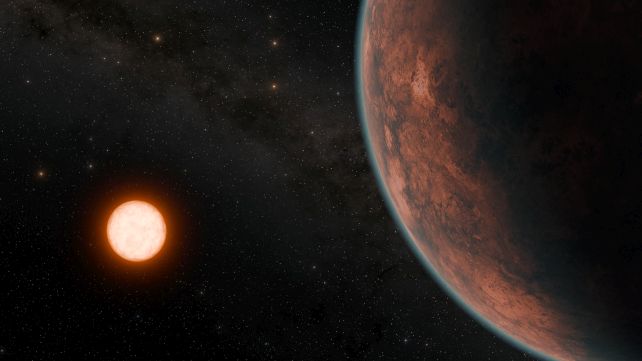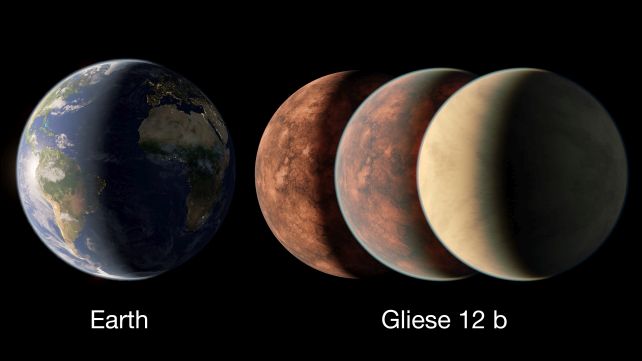A world that bears more than a passing similarity to Earth has just been discovered orbiting a star just 40 light-years from the Solar System.
This exoplanet has a very similar radius to our home planet, suggesting a similar rocky composition. Tantalizingly, Gliese-12b, as the exoplanet is named, is at a distance from its host star that could be habitable to life as we know it.
"In my opinion, this planet will give us the clearest answer yet for any potentially habitable planet as to whether it could support habitable conditions," astrophysicist Shishir Dholakia of the University of Southern Queensland in Australia tells ScienceAlert.
"Its host star is inactive, it's extremely nearby and therefore very characterizable."
What we don't yet know is whether Gliese-12b has an atmosphere. That's the factor that could make a huge difference to whether the world is hospitable to life like Earth, or a scorching hell planet like Venus.
"Gliese-12b represents one of the best targets to study whether Earth-size planets orbiting cool stars can retain their atmospheres, a crucial step to advance our understanding of habitability on planets across our galaxy," Dholakia explains.
Over 5,600 planets outside the Solar System, or exoplanets, have been discovered to date, but we're yet to find an Earth 2.0. Most of the worlds we find are larger.
That's not to say that we've not found those with similar sizes and masses to Earth. We've found quite a few, but finding Earth-sized exoplanets that meet the conditions for habitability is a little more difficult.
One of those conditions is that the exoplanet needs to be within a specific distance range from the star, known as the habitable or Goldilocks zone. This is defined by the temperature inflicted on the exoplanet by the star. The exoplanet needs to be close enough for any water on the surface to be liquid, not frozen; but not so close that any water would evaporate clean away.

In the Solar System, Earth sits smack-bang in the middle of the Goldilocks zone. Venus is a bit too close to the Sun. Mars is right at the outer limits, and proof that just sitting in the habitable zone doesn't guarantee habitable conditions – but it's a starting point for identifying worlds that we should examine more closely for other signs of habitability.
This is what we have with Gliese-12b. It was found in data from the TESS exoplanet-hunting telescope, and Dholakia, his co-lead author Larissa Palethorpe of the University of Edinburgh and University College London, and their team followed up with a number of different telescopes to confirm that the TESS detecting was legit.
They found that the exoplanet has a radius almost exactly the same as Earth's, and orbits its host star once every 12.76 days. Here in the Solar System, that would be way too close for comfort – but the star Gliese-12 is a red dwarf, much cooler and dimmer than the Sun; the radiation the exoplanet receives is about 1.6 times the radiation Earth gets from the Sun.
The estimated surface temperature of the exoplanet is 42 °C (107 °F). Earth, by comparison, has an average surface temperature of 15 °C (59 °F).
Whether or not the exoplanet has an atmosphere could play a huge role in what the surface conditions are like, though.
"We are quoting the planet's 'equilibrium temperature', which is the temperature the planet would be if it had no atmosphere," Dholakia says.
"Much of the scientific value of this planet is to understand what kind of atmosphere it could have. Since Gliese-12b gets in between the amount of light as Earth and Venus get from the Sun, it will be valuable for bridging the gap between these two planets in our Solar System."
Gliese-12b gets about 85 percent of the radiation received by Venus – but Venus is covered in a thick, choking atmosphere that generates a greenhouse effect, resulting in an average surface temperature of 464 °C (867 °F).
"It is thought that Earth's and Venus's first atmospheres were stripped away and then replenished by volcanic outgassing and bombardments from residual material in the solar system," Palethorpe explains.

"Even though further atmospheric analysis is needed to determine whether the planet is habitable, it can still teach us a lot about the habitability pathways planets take (even in our own Solar System!)," Palethorpe tells ScienceAlert.
"Regardless of what the results may be, whilst the Earth remained habitable, Venus did not, and Gliese-12b is somewhere between these two. So as far as investigation into how habitability on planets works, Gliese-12b is a very good place to start!"
Due to its proximity to Earth, radius, position at the edge of the habitable zone of its host star, and low flare activity of that star, Gliese-12b represents possibly the best candidate yet.
The researchers hope that they'll be able to recruit JWST for a closer look, to see if it has an atmosphere, and what that atmosphere is made of.
The research has been published in the Monthly Notices of the Royal Astronomical Society.











No comments